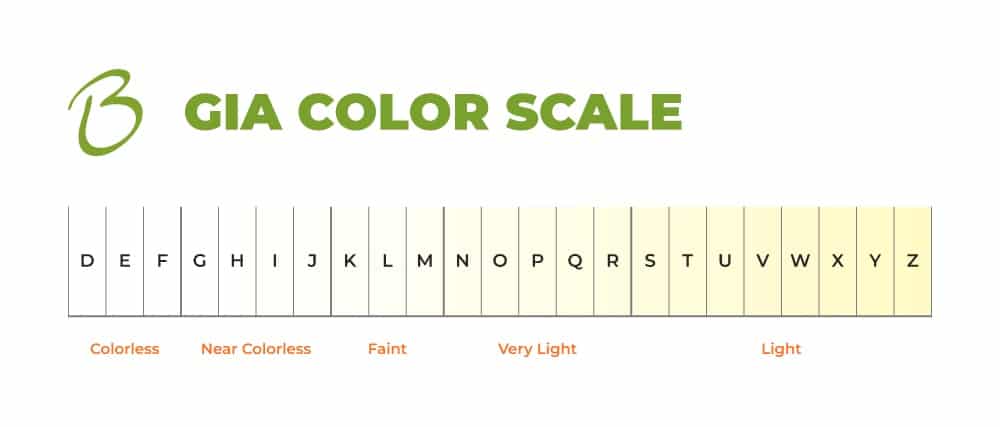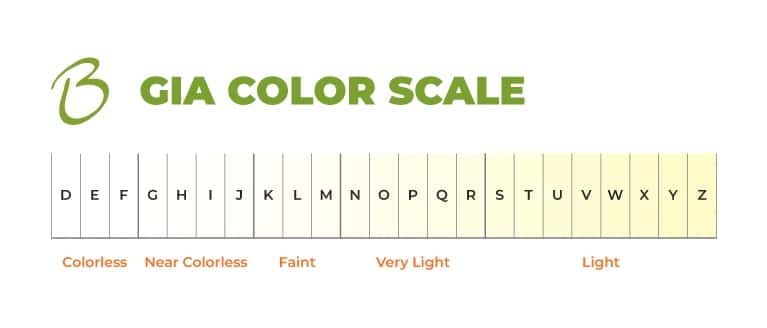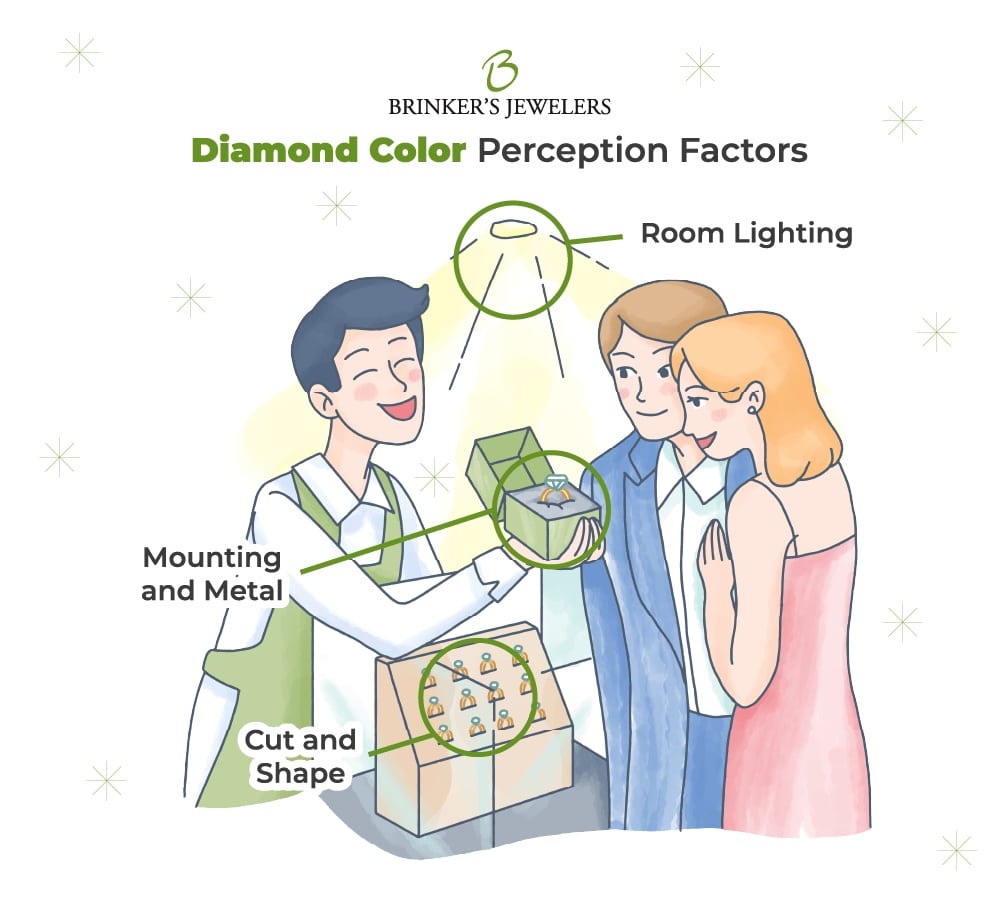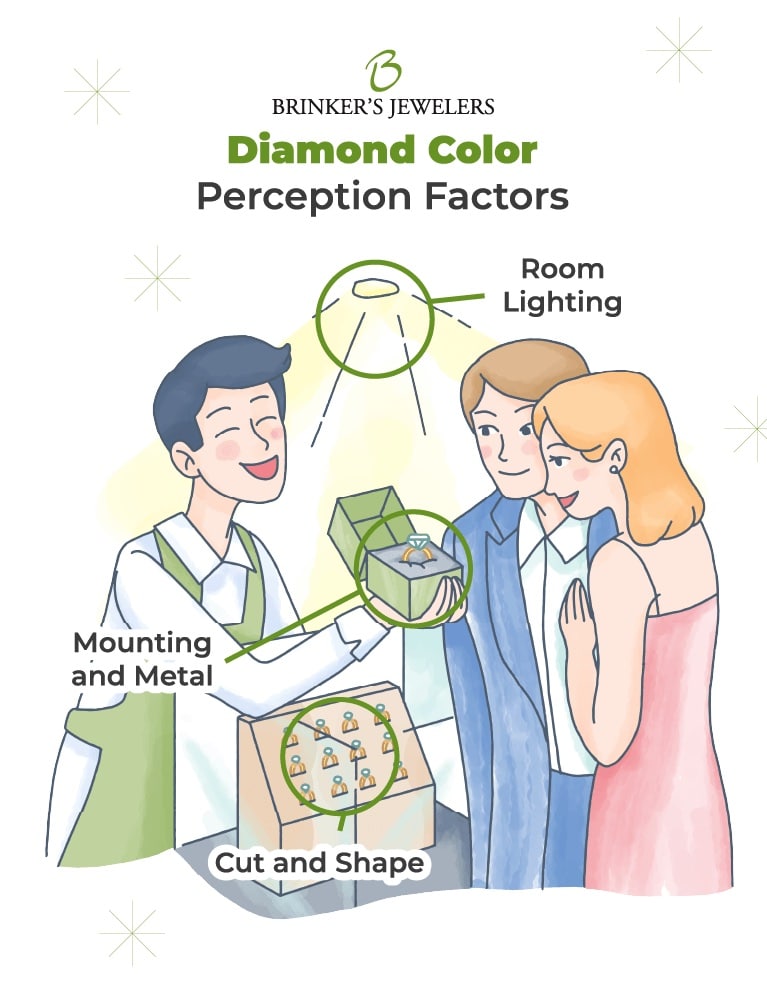When it comes to selecting the perfect diamond, each of the four Cs—Cut, Clarity, Color, and Carat—plays a pivotal role in determining the stone’s beauty and value. Amongst these, color often captures the subtle nuances that can make a diamond truly exceptional. Understanding diamond color is not just about choosing a precious stone; it’s about appreciating the delicate interplay of light and the natural characteristics that make each diamond unique.
The Gemological Institute of America (GIA) has established a color scale to help quantify this aspect of diamond quality, ranging from completely colorless to a light hue.
In this blog post, we’ll delve into the intricacies of the GIA color scale, equipping you with the knowledge to make an informed decision when selecting your next diamond. Whether you’re an engaged couple seeking that symbolic engagement ring, a connoisseur of fine jewelry, or considering a sparkling investment, let’s explore together how diamond color can influence both the appearance and worth of these treasured gems.
The Importance of Diamond Color in Jewelry Selection
The presence or absence of color in a diamond can significantly affect its desirability and market value. Colorless diamonds are traditionally the most sought after, as they allow the most light to pass through and create the most sparkle. However, diamonds come in a spectrum of hues, and even a slight hint of color can alter the stone’s appearance.
As color becomes more apparent, it can either contribute to the diamond’s uniqueness or detract from its perceived purity, thereby influencing buyer preference and the price it commands.
The Basics of Diamond Color
Diamond color refers to the natural hue present within a diamond, ranging from colorless to shades of yellow and brown. It’s one of the most crucial aspects to consider as it can significantly influence a diamond’s beauty.
While the most sought-after diamonds are those that lack any color, appearing perfectly clear, some diamonds exhibit varying degrees of yellow or brown. This natural tint is due to the presence of nitrogen molecules that absorb certain wavelengths of light. It’s a common misconception that slight color variations do not affect value—even subtle differences in color can influence a diamond’s price and appeal, making it essential for buyers to understand the nuances of this characteristic.
In addition to the traditional white diamonds, there are also fancy colored diamonds which include a spectrum of colors such as blue, pink, and green. These are evaluated on a separate scale and are prized for their unique and vivid hues. While white diamonds are valued for their lack of color, fancy colored diamonds are valued for the intensity and distribution of their color.
Understanding the GIA Color Scale Categories
The GIA color scale was developed to provide a standardized method for evaluating a diamond’s color and assigning a grade. The scale consists of 23 color grades, ranging from D to Z, with D being the highest grade and Z being the lowest. The scale is divided into five main categories: colorless, near-colorless, faint, very light, and light. Each category includes a range of color grades that can significantly impact the diamond’s appearance and value. Let’s take a closer look at each category and its defining characteristics.


The Colorless Range (D-F): Characteristics and Rarity
Diamonds within the colorless range, classified from D to F, are treasured for their lack of color, appearing icy white and transparent. These are the rarest and consequently the most valuable, with D-grade diamonds considered the pinnacle of colorlessness and commanding the highest prices. The distinction between D, E, and F diamonds can be subtle, often requiring a trained eye to discern.
The Near-Colorless Range (G-J): Suitable for Various Jewelry Settings
Moving down the scale, G to J diamonds are categorized as near-colorless. These stones may contain minute traces of color, which can typically only be detected when compared directly against diamonds of higher grades. Their slight warmth is often imperceptible once set in jewelry, making them an excellent choice for customers seeking a balance between quality and cost.
The Faint Color Range (K-M): Impact on Price and Appearance
Diamonds graded K to M possess a noticeable color, often a faint yellow or brown hue, which can be seen with the naked eye. While less sought-after than higher color grades, these diamonds offer a more affordable option. The presence of color in these grades can sometimes be minimized when paired with the right setting and metal, providing a beautiful alternative for those on a tighter budget.
The Very Light and Light Color Ranges (N-Z): Understanding their Place in the Market
At the lower end of the scale, diamonds in the N to Z range exhibit more pronounced coloration. These diamonds are less commonly used in fine jewelry due to their visible tints, but they can still offer unique appeal for certain styles or tastes. The cost is considerably lower for these grades, attracting buyers who prioritize size or other characteristics over color.
3 Factors Influencing Diamond Color Perception
While the GIA color scale provides a standardized measure of a diamond’s color, it’s essential to consider other factors that can influence how a diamond’s color is perceived. These can include lighting, cut and shape, and the mounting and metal used in the setting.
Let’s examine each of these factors and how they can impact the appearance of a diamond’s color.


1. Room Lighting
Diamonds can exhibit a range of hues, and the perception of these colors can be significantly affected by lighting conditions. Under different lighting scenarios, such as daylight, fluorescent light, or incandescent light, the same diamond may appear more or less colorless or show varying degrees of yellow or brown tones.
When examining diamonds to assess color, it’s crucial to view them under controlled lighting that simulates daylight. This standardizes the conditions and provides a neutral background that doesn’t skew the perception of the diamond’s color. Different lighting environments, like fluorescent or incandescent light, can alter how the color appears, leading to inaccurate judgments of the diamond’s true color grade.
2. Cut and Shape
The cut and shape of a diamond also play a crucial role in the perception of color. Certain cuts, like the round brilliant, are engineered to maximize light return, which can mask slight color tones, making the diamond appear more colorless. Conversely, shapes such as emerald or asscher cuts have large, open facets that can make color more apparent.
When shopping, consider the overall design and the cut of the diamond in your final decision as it is a significant factor in the jewelry’s overall appearance.
3. Mounting & Metal
The choice of mounting and metal can further influence color perception; for instance, a yellow gold setting may impart a warmer hue to the diamond, while a white gold or platinum setting may enhance its colorlessness.
Additionally, the design and style of the setting can influence how the diamond interacts with light, affecting its overall brilliance and color perception. Therefore, it’s important to consider the setting and metal carefully to ensure they enhance the beauty of the diamond.
Choosing the Right Diamond Color for Your Needs

Image Source: Imagine Bridal
Selecting a diamond that aligns with individual needs and preferences requires a thoughtful balance of various factors, including color. While some may prioritize a higher color grade within their budget, others may find greater value in investing in larger carat weight or better clarity.
To effectively evaluate differences in diamond color, compare multiple diamonds side by side. When diamonds are viewed in isolation, it can be challenging to detect subtle color variations. By observing diamonds next to one another, especially those with adjacent color grades on the GIA scale, you can better discern the nuances in color.
Keep in mind personal preferences, as what is considered the most desirable color can vary from person to person. Some may prefer the warmth of a slightly tinted stone, while others seek the icy appearance of a colorless diamond. Ultimately, the right color grade is the one that satisfies the wearer’s eye and meets their expectations within their budget.
Diamond Color in Relation to Investment Potential
Diamond color significantly influences the long-term value of a stone, making it a critical factor for those considering diamonds as an investment. Higher-grade colorless diamonds (D-F) often come with a premium due to their rarity and high demand. They are typically considered better investments as they tend to retain value over time. Conversely, diamonds with noticeable color (beyond the near-colorless range) might depreciate more rapidly, although they can still be valuable depending on market trends and collector interest.
Investors and collectors should be aware of color trends in the diamond market, as these can affect both the current value and future appreciation of a diamond. For instance, certain fancy colored diamonds, such as pinks or blues, have become highly sought after, sometimes fetching higher prices than their colorless counterparts. Understanding these trends and their implications on investment can guide buyers towards diamonds that align with both their aesthetic preferences and investment goals.
The Role of Brinker's Jewelers in Diamond Selection
Brinker’s Jewelers takes pride in guiding customers through the intricate process of diamond selection with a focus on quality and education. The expert staff at Brinker’s is dedicated to ensuring that clients understand the nuances of the GIA color scale and how it pertains to each diamond’s unique beauty. By offering personalized services, the associates provide tailored advice that helps each customer make an informed choice that aligns with their preferences and expectations.
At Brinker’s Jewelers, the commitment to excellence is taken very seriously by providing customers the ability to view a wide variety of GIA-certified diamonds as well as ethically sourced diamonds. Each diamond is hand selected by an owner of the company ensuring that every customer receives a stone that has been rigorously evaluated and graded according to the strictest standards.
Customers can rest assured that the diamonds they are considering have been assessed for color with precision, guaranteeing the authenticity and quality of their purchase. Brinker’s Jewelers stands as a trusted partner in the journey toward selecting the perfect diamond, with a deep understanding of how color influences both the gemstone’s allure and its rightful place in a piece of fine jewelry.
Select a Diamond that Shines as Brightly as Your Special Occasion

Image Source: Imagine Bridal
As we’ve explored, it is essential to consider the intricacies of the GIA color scale, and how each of the four Cs interacts and affects the overall beauty and cost of the diamond.
Exploring a diverse selection of diamonds is crucial to fully appreciate the subtleties of the GIA color scale. Witnessing firsthand how various color grades affect a diamond’s allure is an invaluable part of the selection process. It is essential to remember that while technical gradings provide a standardized measure of a diamond’s characteristics, the ultimate choice is deeply personal.
Selecting a diamond that resonates with one’s individual preferences and emotions is as important as its cut, clarity, color, or carat weight. Brinker’s Jewelers is dedicated to aiding customers in this journey, offering expert guidance to ensure that the chosen diamond is not only of exceptional quality but also a perfect match for the buyer’s unique taste and style.
Whether you’re searching for an engagement ring that will tell a story for a lifetime or a stunning piece that elevates your jewelry collection, we are here to ensure your investment is as informed as it is inspired. Allow us at Brinker’s Jewelers to guide you through a curated selection of GIA-certified diamonds to find the one that not only meets your expectations but also captivates your heart.
















